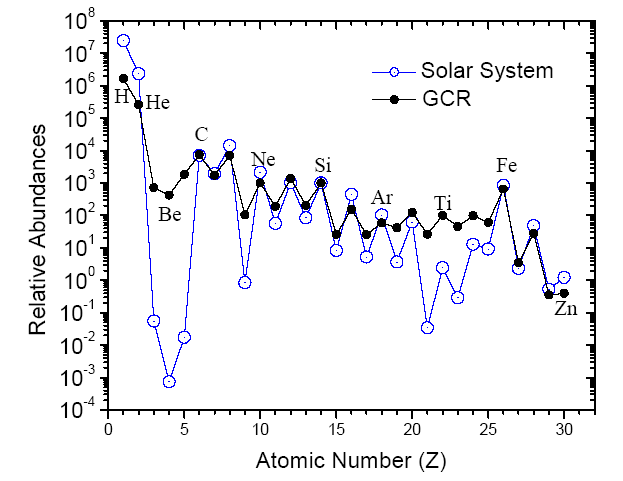
| ACE News Archives | ACE News #83 - Oct 6, 2004 |
Subscribe to ACE News |

The galactic cosmic rays (GCR) arriving near Earth have relative abundances for the more common elements (including C, O, Ne, Mg, Si, Fe, Ni) that are remarkably similar to the relative abundances of these elements in the Solar System. On the other hand, many elements that are rare in the Solar System (including Li, Be, B, F, Sc, Ti, V) have much higher abundances in the arriving GCR. These features of the GCR composition, which have been well known for many years, are nicely illustrated by the figure above, for which the cosmic-ray abundances for the elements heavier than helium are taken from the ACE/CRIS instrument.
The similarity of GCR and SS abundances of the more common elements is evidence that the composition of the GCR source material, which was accelerated on the order of 107 years ago (see ACE News #9), is very similar to that of the nebula that formed the Solar System 4.6 x 109 years ago (see also ACE News #37). The fact that the GCR abundances fill in the deep valleys in the SS abundances is understood quantitatively as the result of nuclear interactions of cosmic rays with interstellar gas. For example, interactions of GCR C, N, O result in fragments of lighter elements, 3Li, 4Be, 5B; similarly interactions of Fe produce fragments of 21Sc, 22Ti, 23V.
In the figure above, abundances of both GCR and Solar System material are normalized to Si = 103. GCR abundances for elements 3Li - 28Ni are CRIS measurements during solar minimum, August 1997 through April 1998, showing relative fluxes at 170 MeV/nucleon. The GCR abundances for the relatively rare elements 29Cu and 30Zn are also from CRIS during solar minimum, but include the full CRIS energy range for these elements, 150 - 550 MeV/nucleon. The GCR abundances for H and He are for solar minimum at 170 MeV/nucleon, derived from measurements by the balloon-borne instrument BESS and the GSFC instrument on the IMP-8 spacecraft. The Solar System abundances in this figure are from the compilation by K. Lodders (Ap.J., 591, 1220, 2003) and represent the abundances of elements in the proto-solar nebula.
Contributed by Martin Israel of Washington University, with contributions from Jeff George of the Aerospace Corporation, Richard Mewaldt of Caltech, and Georgia deNolfo of NASA/GSFC. Questions or comments can be addressed to mhi@wuphys.wustl.edu.
Last modified 06 Oct 2004, by